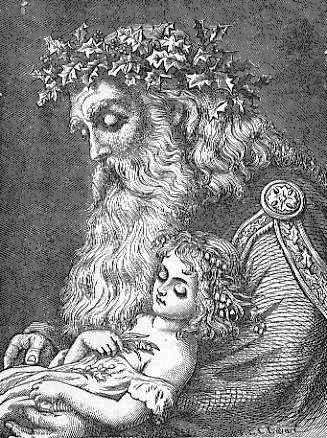The kids came to me in great agitation after school one year near Christmas. Other kids at school had taunted them with the claim that Santa Claus was dead, and buried under a pile of turkeys.
Surely the realization that one has been lied to about Santa is one of the great traumas of childhood. Surely others remember, as I do, that moment of realization, that one’s simple childhood faith had been taken advantage of by those you trusted the most, apparently in order to mock you for trusting them. And isn’t it sinister that adults get their jollies out of doing this?
Who is this guy Santa, anyway?
The official story is that he is Saint Nicholas of Myra/Bari—“Saint Klaus.” Saint Nicholas’s feast day is December 6, so he seems to fit as part of the Christmas season. On the other hand, he has no particular connection with the Christmas story, and we know very little about him. Why has he become so prominent?
One answer is the many miracles that have been associated with him, and his relics. This can witness to a saint’s importance in heaven, even if he was not well-known in life. Nicholas was also said to be from a wealthy family, and to have distributed his inheritance to the poor.
There is, on the other hand, an unsettling tale of his slapping some Arian at the Nicene Council. This, whether true or not, suggests Nicholas was not good at restraining his impulses.
The modern Santa, fat, jolly, and red of complexion, indeed suggests a Falstaffian figure. The conventional English “Father Christmas,” who may not have anything to do with Saint Nicholas, is explicitly such, going door to door with his wassail bowl advocating general inebriety. The modern Santa seems to encourage just such self-indulgence. He serves to make “getting stuff” overshadow the spiritual aspect of Christmas. He seems, in this sense, an anti-Christ.
“Nick” is actually a German term for a demon, or even for the Devil; you sometimes hear the Devil referred to in English as “Old Nick.” Has this resemblance in name associated the Devil himself with the reverend Saint Nicholas over time?
Why is his home at the North Pole? Why is this Mediterranean resident associated with the cold and the Far North?
There is another figure whose home is at the North Pole: the pagan god Cronus, aka Saturn, who is said to rule over the Hyperboreans. Cronus is often identified with Time, and so his appearance at end-of-year festivities makes sense. And Saturn’s old pagan feast, Saturnalia, a time of unbridled self-indulgence, corresponds more or less with the Feast of St. Nicholas.
The most important story associated with Saturn/Cronus is that he ate his own children as they were born. Not a cheerful association for Christmas, the birth of the Christ child. In ancient times, the Greeks used to kill their children in his honour. So did the Carthaginians, the Phoenicians, and the Canaanites. He would perhaps correspond in the Christmas story to King Herod, who ordered every child under two years old slaughtered, in hopes of never being supplanted.
 |
| A 19th Century depiction of Cronus as "Father Time." |
He represents the implicit and rarely acknowledged hostility of adults towards each new generation. A selfish adult can look in their child’s eyes and resent the knowledge that the child will live on after the parent is dead.
I think Santa as we honour him today is the bad guy. He is the face of narcissistic parenting.
Merry Christmas.


















No comments:
Post a Comment